Hair Therapy & Transplantation
Open Access
ISSN: 2167-0951
ISSN: 2167-0951
Research Article - (2022)Volume 12, Issue 3
Background: Follicular unit extraction technique has revolutionized hair transplant globally. Its use amongst African patients has not been well established. We share our experiences with this technique on predominantly African patients.
Materials and methods: This was a prospective audit of patients managed by follicular unit extraction transplant at the Nairobi hairhub trichology centre, Kenya between January 2013 and December 2019. Patients who underwent hair transplant were followed up for a minimum of two years. Patient’s bio data, outcomes and complications were noted during the follow up period.
Results: A total of 935 patients were operated on during the six year study period. Patients of African descent were 899 followed by 26 Asians and 10 Caucasians. The male to female ratio was 1:4. The age range for the patients was 12 to 61 years with a mean age of 38.4 years. The most common indication was traction alopecia followed by female baldness alopecia. The average hair transplant per patient was 1150. More than 90 percent of patients were satisfied with the outcome at two years of follow up. The most common complication was hypertrophic scar which occurred in about 0.5 percent of the patients.
Conclusion: Follicular unit extraction transplant surgery technique as experienced in this study has good surgical outcomes with minimal complications in patients with the African hair. Proper selection of patients followed by meticulous surgery technique is paramount to good outcomes.
Alopecia; Hair transplant; Follicular unit; Female baldness
Hair transplant since its inception has become one of the most common aesthetic procedure with a general upward trajectory globally [1-2]. The procedure has seen many innovations, from strip hair transplant, Follicular unit extraction and lately robotic unit extraction and transplant [1-3]. Follicular unit extraction transplant first described by Masumi Inaba in 1988 in Japan and popularized by Wood et al., in Australia has become the gold standard of hair transplant surgery globally [2-5]. Its use in African hair has however not been well documented to the best of our knowledge. It is therefore not clear whether similar outcomes could be achieved. The African hair has been noted to have some subtle differences compared to the Caucasian and Asian hairs [6-8]. Further, African patients are prone to keloids and hypertrophic scars [9]. Such complications on hair transplant patients could be disastrous. In spite of these concerns more patients of African descent are opting for these services. In this paper we share our experience with hair transplant in predominantly African clientele over a six year period.
This was a prospective audit of patients managed with follicular unit extraction technique for treatment of scalp alopecia at the Nairobi hairhub trichology centre. Ethical approval was sort from the institutional review board. Consent to participate in the study was gotten from the patients. Patients who presented with alopecia and offered follicular unit extraction hair transplant technique were recruited. Patient’s bio data including age, sex and ethnic profile was recorded.
A thorough clinical examination was then done to determine the aetiological cause of alopecia and to characterize the extent. Patients with history of keloids or those with inflammatory or scarring disorders as confirmed by histology were excluded. Surgery was done under local anesthesia except for minors who had general anesthesia. Donor and recipient sites were cleaned with Povidone-iodine solution and draped with sterile dressings. They were then infiltrated with bupivacaine/ adrenaline saline solution. Hair follicles were harvested with either 1 mm or 1.25 mm power driven straight punch (Figure 1).
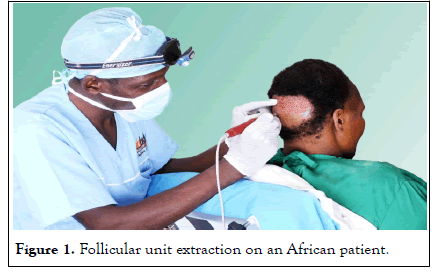
Figure 1: Follicular unit extraction on an African patient.
In each harvest an estimate of the transected follicles were noted and calculated as transaction rate. Prior to transplantation the follicles were put in a kidney dish containing cold normal saline. The recipient site was then prepared by creating holes using a wide bore size 16 needle. With the aid of fine instrument and loupe magnifications the hair follicles were meticulously transplanted into the holes. Patients with extensive alopecia were offered two to three sessions of transplantation surgery procedure.
Post operatively patients were given cephazolin, Paracetamol and Ibuprofen for one week. Normal saline was used to irrigate the grafted hair for at least four times a day for one week. The recipient site was dressed with an antimicrobial foam dressing. Reviews were done on day 7, 14 and every month for at least one year (Figures 2-4).
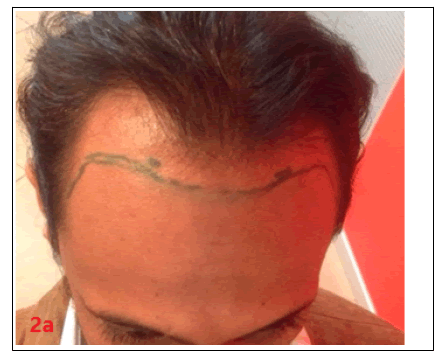
Figure 2a: Male Caucasian patient with androgenic alopecia before (2a) and after (2b) hair transplant.
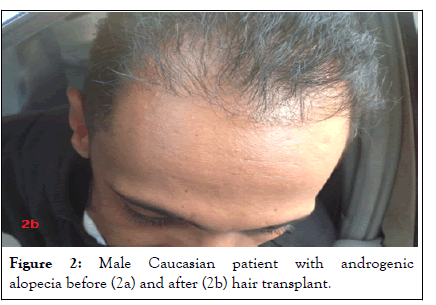
Figure 2b: Male Caucasian patient with androgenic alopecia before (2a) and after (2b) hair transplant.
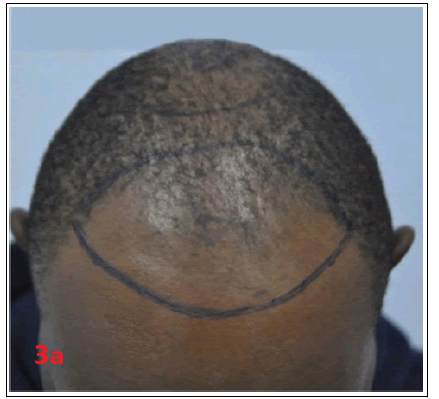
Figure 3a: African Male androgenic patient with hair transplant at one year of follow up (3a and 3b).
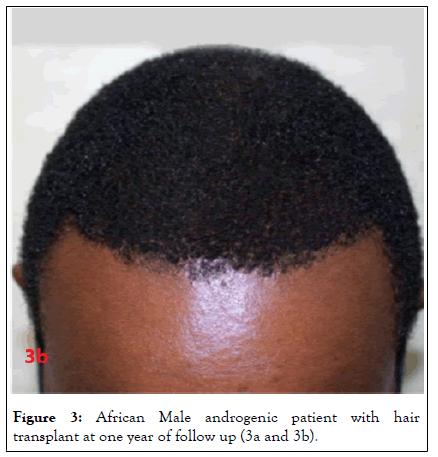
Figure 3b: African Male androgenic patient with hair transplant at one year of follow up (3a and 3b).
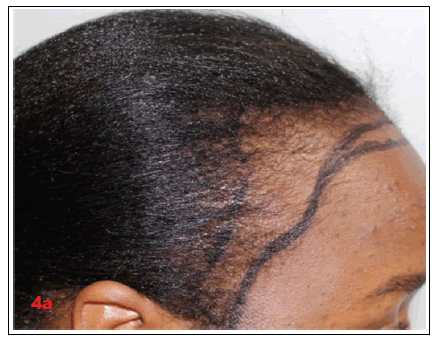
Figure 4a: Female patient with traction alopecia with before and after hair transplant (4a and 4b).
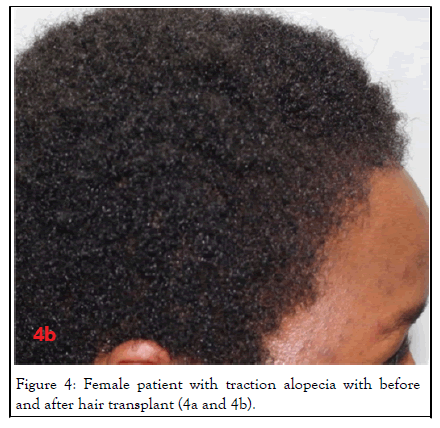
Figure 4b: Female patient with traction alopecia with before and after hair transplant (4a and 4b).
A total of 3200 patients with alopecia were seen in the clinic in the six year study duration between January 2013 and December 2019. Out of this 935 patients had hair transplant surgery done. The age ranges for the patients was 12 years to 61 years with a mean age of 38.4 years. The male to female ratio was 1:4. Table summarizes age of presentation for the patients with their respective gender (Table 1).
| Patients age | Female | Male | Total | Percentage |
|---|---|---|---|---|
| <15 years | 0 | 1 | 1 | 0.1 |
| 15-20 | 35 | 15 | 50 | 5 |
| 20-25 | 50 | 15 | 65 | 7 |
| 25-30 | 125 | 34 | 159 | 17 |
| 30-35 | 183 | 39 | 222 | 23.5 |
| 35-40 | 160 | 24 | 225 | 24 |
| 40-46 | 77 | 23 | 100 | 10.9 |
| 45-50 | 61 | 20 | 81 | 9 |
| >50 | 54 | 20 | 34 | 3.5 |
| Total | 745 | 191 | 936 | 100 |
The aetiological causes for alopecia were traction alopecia 66%, female baldness alopecia 15% and male baldness alopecia 13% (Table 2).
| Diagnosis | Frequency | Percentage |
|---|---|---|
| Traction alopecia | 621 | 66 |
| Female baldness alopecia | 140 | 15 |
| Male Baldness Alopecia | 122 | 13 |
| Post burn alopecia | 9 | 1 |
| Eye brow restoration | 27 | 3 |
| Hairline lowering | 17 | 2 |
| Total | 936 | 100 |
Ninety seven percent of the hair transplant done was amongst patients of African descent followed by 2% Asians and 1 percent Caucasians (Figures 2 and 5). The average number of hair transplants done was 1150 per session. Eighty seven percent of the patients had one session of hair transplant with the remaining 13 percent of the patients two sessions or more. The transection rates were as follows 22 percent for African hair, 11 percent for Asian hair and 10 percent for Caucasians hair types.
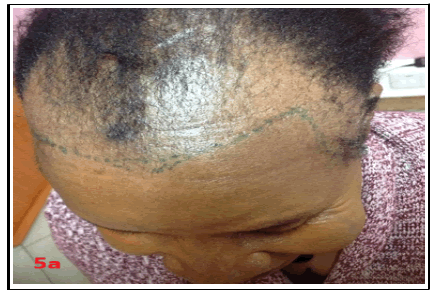
Figure 5a: African patient with traction Alopecia, before (5a) and after (5b).
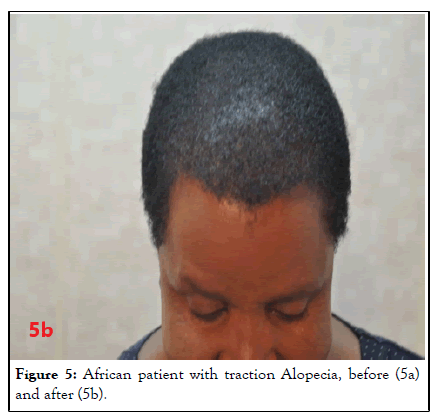
Figure 5b: African patient with traction Alopecia, before (5a) and after (5b).
Patient’s satisfaction was assessed at two years of follow up (Figures 2,3,5). Of the eight hundred and thirty patients who were reviewed 15 percent were extremely happy with the outcome 35 percent were very happy and 21 percent were happy with the outcome (Table 3).
| Patients satisfaction | Frequency | Percentage |
|---|---|---|
| Extremely happy | 124 | 15 |
| Very happy | 290 | 35 |
| Happy | 174 | 21 |
| Satisfied | 170 | 20 |
| Unhappy | 79 | 9 |
| Total | 830 | 100 |
Complications encountered in the study were hypertrophic scars in 5 patients, infections 3 patients and hair graft failure in 5 patients.
The Hair transplant surgery is one of the aesthetic surgical procedures that have seen tremendous growth globally over the last two decades [1-5]. Locally the demand for this service has shot up in line with the global trends. Among reasons for the increase is the relatively low complication rates associated with follicular unit extraction visa vie the traditional strip hair transplant procedure [10]. There is however little data on the practice of hair transplant and in particular follicular unit extraction techniques among African patients.
African hair compared to the other types has unique anatomical and social cultural related factors that potentially makes hair transplant difficult [7,8]. Among the anatomical differences is the fact that the African hair follicles have a more parallel orientation into the scalp compared to the more perpendicular orientation of the other subtypes [6-8]. Further the hair density is less and has a relatively slow growth phase. The hair is arranged in a haphazard manner with no definite patterns on the scalp. In addition due to the dark skin complexion these patients are more prone to keloid and hypertrophic scars [9]. Social cultural practices that make African patients scalp different is the fact that majority of African women practice plaiting of the hair from a relatively young age that leads to not only traction alopecia but micro scarring at the dermal and sub dermal level that may interfere with the quality of recipient tissue. In spite of these our study demonstrated that good outcomes could still be achieved by carrying out follicular unit extraction hair transplant among patients of African descent.
The epidemiological findings of the patients operated on demonstrated that majority of our patients were in a relatively young age group with a mean age of 38.4 years. The youngest patient operated on was 12 years with the oldest 61 years. Male patients had a relatively older age group compared to their female counterparts. Majority of the patients in our study cohort were female with traction alopecia the most common cause of alopecia, followed by female pattern baldness and male pattern baldness. (Figures 2-4) Sandor et al., in a predominantly caucasian patients had mean age of 36. 9 years [11]. They had androgenic alopecia contributing to over 80 percent of their cases compared to only 13 percent in our series. No case of traction alopecia was reported in there series. It is however worthy noting that a small but significant proportion of patients who had hair transplant had burn associated alopecia a practice that should be encouraged given that other forms of post burn alopecia such as tissue expansions are not readily available.
Though majority of the patients managed were of African descent, a comparison with the other hair types revealed higher transection rates leading to many wastages, African hair on the other hand had the highest number of multiple follicles per harvest, a factor that made it easier to achieve the required density faster. The hair was also predominantly arranged in a haphazard manner as opposed to regular pattern for the Asian or Caucasians hair types. The pop up rates were on the hand noted to be more among the Africans that the other races.
Due to the above observations we adjusted our surgical techniques so as to reduce on the complications and have good outcomes. We advocated for a bigger punch for harvesting the African hair so as to reduce on the transactions rates. Sanuzi et al., had noted similarly high transection rates among patients with African hair type. He advocated for the use of a curved hair punch [12]. Due to the high pop up rates, we opted to have transplantation holes created at least 20 to 30 minutes prior to the actual transplantation to allow for the sippage of fluid and release tension.
The haphazard manner of arrangement of the hair in the African patients on the other hand made hair transplant easier compared to the other races since there was no need for transplant to be done in a particular pattern.
Overall patient’s satisfaction rate was high with more than 90 percent of the patients being happy with the outcome at two years of follow up. There was no difference in the satisfaction rate of patients among the different races. However female patients had a higher satisfaction rate compared to their male counterparts. Liu Y, Liu F, et al., in assessing patients satisfaction following hair transplant noted an improvement of 29.62 from a baseline, 46.97; to a 6-month, 76.59. Muhammad Ahmad in his study published in the Journal of Pakistan Association of Dermatologists noted patient satisfaction rate of about 98 percent with follicular unit traction technique [13]. We did not find any study comparing patient’s satisfaction rate following follicular unit extraction technique.
Complications encountered in this series were few probably suggesting that follicular unit extraction technique is a safe procedure for African Hair as well. The overall complication rate was less than 1 percent. The most noted complication was hypertrophic scars in less than 0.5 per cent of the patients. Others were infection at the donor site and hair transplant failure. Santto et al., had an overall complication rate of 4.5% in patients managed by strip transplant technique with hypertrophic scars and keloids contributing to the highest number of complications followed by folliculitis and scar necrosis [14]. Amit et al., in another study reported only two cases of keloid formation after follicular unit extraction technique. In our series we didn’t report any case of keloid formation despite the fact that most of our patients were Fitz Patirck type 6. This could be attributed to good patient selection with only patient with no history or family history of keloids being subjected to hair transplant surgery.
In conclusion, follicular unit extraction technique is a safe procedure for patients with African hair type. Despite specific challenges due to the sattle differences in the anatomic arrangement of the African hair high patient satisfaction with relatively low complication rates can be attained. It is however paramount to have proper selection of patients with patients prone to hypertrophic scars and keloids being discouraged from undergoing the surgical procedure.
Citation: Wanjala N, Dindi K, Musyoka M (2022) Follicular Unit Extraction on Predominantly African Hair: Our Experience. Hair Ther Trasplant. 12:193.
Received: 25-Aug-2022, Manuscript No. HTT-22-19002; Editor assigned: 29-Aug-2022, Pre QC No. HTT-22-19002 (PQ); Reviewed: 13-Sep-2022, QC No. HTT-22-19002; Revised: 19-Sep-2022, Manuscript No. HTT-22-19002 (R); Published: 26-Sep-2022 , DOI: 10.35248/2167-0951.22.12.193
Copyright: © 2022 Wanjala N, et al. This is an open-access article distributed under the terms of the Creative Commons Attribution License, which permits unrestricted use, distribution, and reproduction in any medium, provided the original author and source are credited.